© Use of content without authorization is prohibited

Puglia
Bari - Barletta Andria Trani - Brindisi - Foggia - Lecce - Taranto
The "heel" of the Italian boot; an enchanting land made up of a vast plain called the Tavoliere with a very long coastline that is mostly low and sandy and at times high and rocky. Among the most beautiful areas I mention: the Gargano, with its scenic roads and the Umbra Forest rich in flora and fauna; the Murge, hills full of olive groves, and atop one of these the mysterious Castel del Monte, an octagonal fortress that dominates the territory with its fascinating farmhouses surrounded by sun-scorched fields; Salento with velvet beaches and a sea to rival the Caribbean. And then cities and villages like Ostuni with its white walls, Alberobello with its characteristic trulli, Lecce, the capital of Baroque. Among my favorite dishes are Orecchiette with Turnip Tops, Gargano Fish Soup accompanied by the fabulous Altamura Bread. A good red wine like Primitivo di Manduria is ideal to accompany meals.
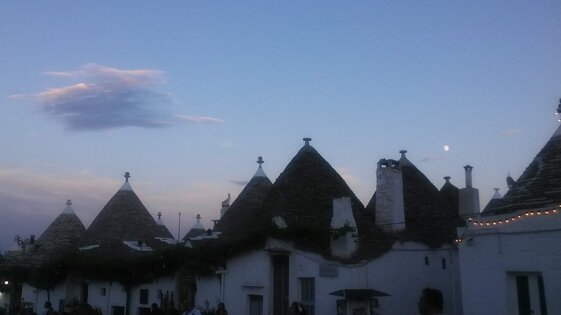
Province of Bari
Area: 3865.14 km² Population: 1,221,782 Municipalities: 41
Alberobello: sunset over the trulli
Alberobello: sunset over the trulli
Travel photos...
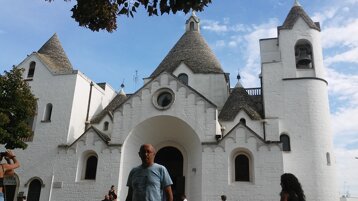

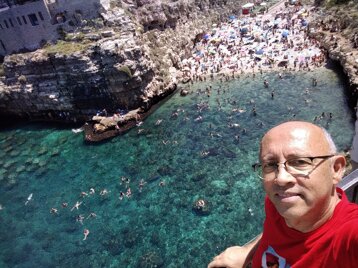
Gioia del Colle
Polignano a Mare
Trullo church Parish of Saint Anthony of Padua
The entrance to the town reminds you that there is an important military airport here
The famous beach of Lama Monachile

Province of Barletta-Andria-Trani
Area: 1542.10 km² Population: 377,973 Municipalities: 10
Barletta: the Castle
Barletta: the Castle
Travel photos...

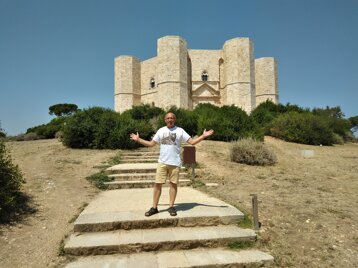

Barletta
Castel del Monte
Castel del Monte
Curci Theater inaugurated in 1872
Medieval castle built by Emperor Frederick II of Swabia
Bare interiors of the castle

Province of Foggia
Area: 7008.69 km² Population: 590,304 Municipalities: 61
Tremiti Islands: Abbey of Santa Maria a Mare
Tremiti Islands: Abbey of Santa Maria a Mare
travel stories...

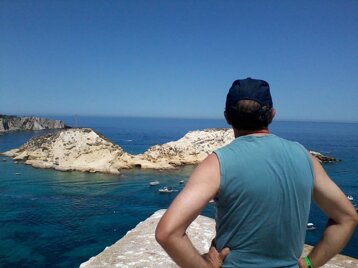
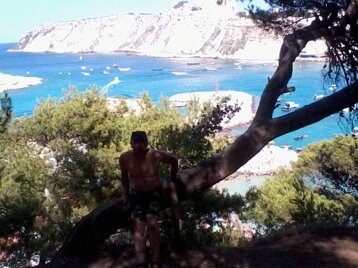
Marina di Lesina
Tremiti Islands: San Nicola
Tremiti Islands: San Domino
Here, in this location at the foot of the Gargano, I had my only experience in an all-inclusive holiday village. I arrived in the late afternoon after an exhausting journey due to a long traffic jam on the Bologna ring road, entered the village and was welcomed by the hit song of the moment “Vieni a ballare in Puglia.” The bungalow where I stayed was spacious, with two bedrooms and a kitchen that I obviously never used. The town is modern, with holiday homes, restaurants, and little else. The beach is the highlight of this place; I reached it aboard a convenient shuttle train, it was huge and had fine, hazelnut-colored sand; the sea, with shallow waters as I like, had somewhat murky water, perhaps due to the strong wind that blew every day. Despite the tennis tournaments and archery competitions, in just a few days I saw my waistline grow because of the excellent and abundant buffet-style cuisine. After dinner, I alternated between musical and theater shows held in the amphitheater and Latin dance evenings; in short, what a tough life…
I left early in the morning from Rodi Garganico, on a crowded ferry, and after an hour of sailing I arrived at the island of San Nicola. Right after landing, there is a bar where, besides having a good coffee, it is wise to use the bathroom since you won't find any others later. Backpack on my shoulders, I head up to the Abbey of Santa Maria a Mare. I walk on an evocative cobblestone path between mighty walls; every now and then, through a loophole, you can glimpse the sea in a beautiful shade of blue. Sweaty on this sultry mid-July day, I arrive in front of the sanctuary entrance; the facade bears the marks of shots fired by the English fleet during the Napoleonic occupation of the island. Sitting on the steps of a monument, I share my sandwiches with a stray cat; bread for me, the filling for him. I stroll along the ancient colonnade of this abbey, first Benedictine and then Cistercian, and with my imagination I go back to the year one thousand and picture the monks gazing out at this incredible landscape. From above, while a warm Scirocco wind caresses my face, my gaze falls on the uninhabited island of Capraia. In front, the green island of San Domino, my next destination.
The visit to San Domino begins with a tour around the island. The sea, on this clear summer day, is a pastel blue. We start by spotting the Elephant Rock, a huge rock resembling a pachyderm with its trunk in the water. We continue by visiting the sea caves: the first is the Grotta delle Viole; then we move on to the Grotta del Bue Marino, so called because in the distant past some specimens of the Monk Seal were sighted here, a rare species now found only in Sardinia; the cave is about 70 meters long, at the end of which there is a small beach that can only be reached by swimming... the water is four meters deep, which, given my poor swimming skills, is enough to make me give up on reaching it. The boat stops at a spot where there is a statue underwater that the more daring dive down to admire. Back on land, I walk along a scenic road overlooking a sea of many colors. When I reach the crowded beach of Cala delle Arene, I find a little corner to put down my backpack and finally swim in the transparent water of the Tremiti Islands.

Province of Lecce
Area: 2797.77 km² Population: 763,778 Municipalities: 96
Marina di Pescoluse: Maldives of Salento at sunset
Marina di Pescoluse: Maldives of Salento at sunset
travel stories...
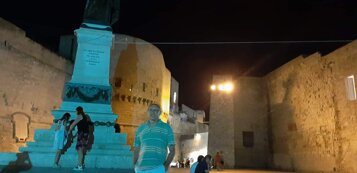
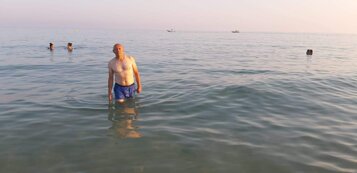
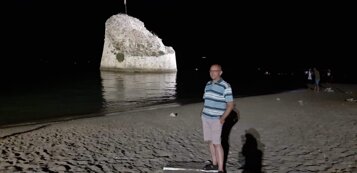
Otranto
Beaches of the Ionian Salento
Torre Pali
I visited several beaches in the area equipped with an umbrella and mat so I could save money and choose each time the best spot to sunbathe: the first one, north of Torre Pali, is the Spiaggia dell’Isola della Fanciulla, wild and rich in vegetation, from which you can easily swim to the small island of the same name, just being careful of the many rocks submerged in the water; the one in Marina di Salve is small with houses very close by, and near the tower there are little fish that bite, perhaps annoyed by the many traps called nasse set by amateur fishermen; south of Torre Pali is my favorite, a long stretch of light sand between Mediterranean vegetation and crystal-clear sea, also known as the “Seychelles of Salento,” at first free and wild, then with many equipped lidos. Going three kilometers further south, just before Marina di Pescoluse, there are the famous “Maldives of Salento,” beautiful with clear sea and soft golden sand, but too crowded and the only beach club with daily prices ranging from a minimum of 32 euros in the last row to 40 euros for an umbrella and 65 euros for a gazebo. After 6 p.m. I enter the parking lot for free, and after laying out my beach towel I waited for the beach to empty out to take the best photos, immerse myself in the transparent water, and finally, with my feet massaged by the fine sand, I walk enjoying a romantic sunset.
I had long dreamed of seeing this place and my expectations were not disappointed. Luckily, I find free parking near the port, just steps from the center. In front of my eyes, the imposing Aragonese Castle. I cross a drawbridge over the mighty walls and find myself immersed in a maze of alleys bustling with people. I climb higher and from one of its bastions, where for centuries the sea was watched for enemy ships, smartphone in hand, I look for the best shot. The Cathedral of Santa Maria Annunziata is a church that preserves the relics of the martyrs who, during the Turkish invasion of 1480, refused to renounce their faith. Not far away, towards the port, I come across the even more beautiful Church of San Pietro, a testament to the city's Byzantine past. Dinner on the terrace of a little restaurant in an alley of the historic village. Evening stroll along the seafront; I cross the square with the monument to the Heroes in the center and enter my favorite corner through the Alfonsina Tower. Dim lights give a Renaissance atmosphere to the castle walls up to Porta Terra; once past that, you return to modernity. While the stars come down to light up the night in Otranto, I have fallen in love with this city with its oriental charm, and as we know, for those in love, the sky is always beautiful.
The road that brings me here is unfortunately littered with filth, somewhat ruining the atmosphere of the landscape made up of endless olive groves; numerous makeshift signs, even written in dialect, curse the litterbugs, making me understand that many Apulians fight this form of bad behavior as best they can. I rented a house in this corner of Salento to relax, alternating days at the sea with excursions inland. From the villa, I cross the new wooden bridge built to pass over the canal where the boats are moored; at night the bridge lights up with a green glow and on Thursday evenings a small market takes place in the nearby streets, with stalls festively lit. Once at the bar, a typical breakfast with Pasticciotto pugliese, a shortcrust pastry filled with custard or, as I like it, with chocolate; accompanied by a good Lecce-style coffee prepared cold and with almond milk. Afternoon on the beach with my eyes on Torre Pali, once a lookout bastion against Saracen pirates, today a nest and shelter for seabirds. Evening of pizzica in a nearby town with a concert by Alla Bua, a folk music group; here I let loose among thousands of people bewitched by the obsessive rhythm of Salento folklore. On the night of departure, a pleasant walk with my feet in the water, and in a dazzling moonlight, a last look at the old tower by the sea.